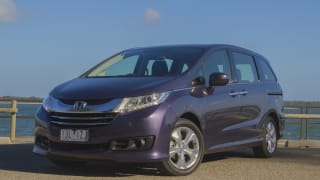
Honda Odyssey 2018 review
Honda's sleek Odyssey has long been a popular choice for Australians in need of more seats plus space to move the gear of all those occupants.
Browse over 9,000 car reviews
You know Picasso? He died a long time ago. And now the Picasso badge - which has adorned Citroen’s people-mover models internationally since way back in 1999 - is set to die, too.
As a result, the Citroen Grand C4 Picasso is set to be relabelled the Citroen Grand C4 Spacetourer, following a new van naming convention set in Europe. It’s a shame, because Picasso is undoubtedly one of the better known nameplates that Citroen has… and let’s be honest, Citroen needs all the help it can get in Australia.
But before we see the name change, the company has made an addition to the current Grand C4 Picasso range: a new price-leader, the Citroen Grand C4 Picasso petrol, is now on sale - and it cuts the price of the seven-seat people mover by a huge $6000 compared to the diesel.
That amount of money will buy you a heck of a lot of petrol, so does the new base model version in the Citroen Grand C4 Picasso 2018 range make more sense than its expensive diesel sibling?
| Citroen Grand C4 2018: Picasso Exclusive Bluehdi | |
|---|---|
| Safety rating | |
| Engine Type | 2.0L turbo |
| Fuel Type | Diesel |
| Fuel Efficiency | 4.5L/100km |
| Seating | 7 seats |
| Price from | $22,880 |
With a sub-$40k price tag, the Citroen Grand C4 Picasso suddenly enters a realm of relevance that it didn’t before.
The official list price is $38,490 plus on-road costs, and if you haggle hard, you might be able to get one on the road for about forty grand.
As mentioned, it’s a seven-seater, and it comes rolling on standard 17-inch alloys.
Some of the other features include auto headlights, auto wipers, LED daytime running lights, puddle lights, smart key and push-button start, and an electric tailgate.
You don’t see it in the interior images here, but if you buy the most affordable Grand C4 Picasso model you get cloth seat trim, but still a leather steering wheel. And of course there’s the 7.0-inch media screen with built-in sat nav that displays on the 12.0-inch high-definition screen up top.

There’s Bluetooth phone and audio streaming as well as auxiliary and USB points - but in this day and age, just one USB isn’t terrific. I guess the first trip to the servo could include the purchase of a couple of those 12-volt USB adaptors.
As for people-mover competitors at this price point? There are a few, such as the LDV G10 (from $29,990 drive-away), the Volkswagen Caddy Comfortline Maxi (from $39,090), the Kia Rondo Si (from $31,490) and the Honda Odyssey VTi (from $37,990). The best people-mover we reckon you can buy - the Kia Carnival - is relatively exxy, starting at $41,490, and it’s more physically imposing, too.
Or you could be like the vast majority of buyers and forego the French charm and Avantgarde styling of the Citroen for a mid-sized SUV with seven seats. Examples priced near the entry-grade Grand C4 Picasso include the Mitsubishi Outlander, Nissan X-Trail, LDV D90, Holden Captiva or even the Hyundai Santa Fe or Kia Sorento.
If you were to suggest there isn’t anything interesting about the design of the Citroen Grand C4 Picasso, it would pretty much intone that you’re vision impaired. This is - without question - one of the most intriguing and interesting looking vehicles on the market today.
With its front-end design mirroring the other models in the French maker’s range - sleek LED daytime running lights sitting either side of a chrome grille with central chevron, the main headlights below and some chrome trimming on the lower bumper - this is easily distinguishable as a Citroen. There’s no confusing it with a Kia, Honda, or anything else, in fact.
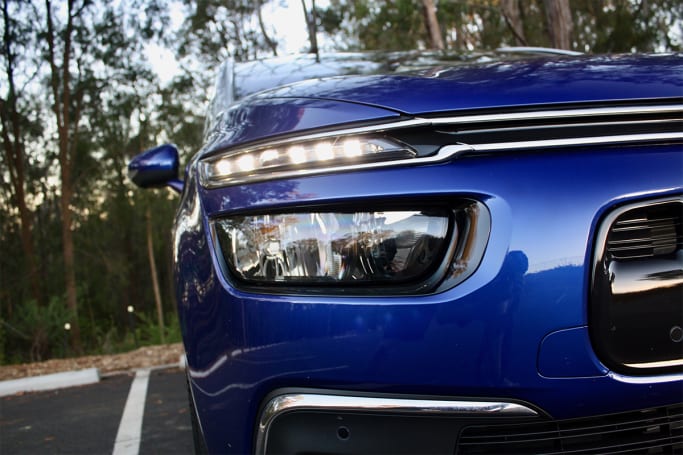
The large windscreen and panoramic sunroof help give it that two-tone look, and the beautiful silver C-shaped rim that surrounds the glasshouse is one of the best styling touches in the automotive business.
Our car rides on the standard 17-inch wheels wrapped in grippy Michelin tyres, but there are optional 18s if you want something that fills the wheelarches a little more.

At the rear there are some nicely styled tail-lights, and its hips are broad, giving it a nice amount of presence on the road when you’re sitting behind it in traffic.
I think Spacetourer works better as a name: Picasso was known for artworks that were challenging to make sense of. This vehicle presents no such conundrum.
The interior is also one of the most stunning in the business: I love the two-tone dashboard, the stacked twin screen layout, the minimalism of the controls and the massive windscreen with innovative adjustable headlining - yes, you can move the front part of the headlining back and forth, and the sun-visors move with it.
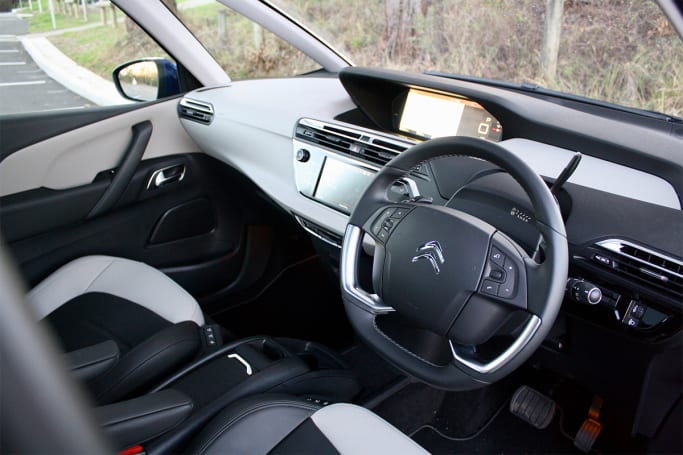
Our car had the optional 'Leather Lounge' pack, which adds dual-tone hide trim, seat massage functions for both front seats, plus heating for both front seats, and the front passenger seat has an electrically operated leg/footrest. This interior trim is nice, but it comes at a price… ahem, a big price: $5000.
As you might expect, that’s hard to justify if you’re trying to save money on your seven-seat people-mover. But ignore that: let’s take a deeper dive into the cabin.
It’s kind of amazing just how much Citroen has managed to fit into the Grand C4 Picasso. It measures 4602mm long - which is just 22mm (an inch) longer than a Mazda3 sedan! As for the other dimensions, the width is 1826mm, and the height is 1644mm.
How many seats does the Citroen Picasso have? The answer is seven, whether you choose the petrol or the diesel - but notably, the petrol model has a space-saver spare wheel under its boot, where the diesel misses out because it has an AdBlue system.
Yep, by some marvel of packaging magic, the brand’s engineers managed to pack seven seats, a reasonable boot (165 litres with all seats up, 693L with the back row folded, 2181 with the five rear seats folded), plus a spare tyre and a lot of style into a very compact package.
That’s not to say this is a seven-seater to suit all the needs of buyers who want seven seats. The back row is tight for anyone nearing 183cm (six-feet) tall, and there is no third-row airbag coverage. According to the French brand, the occupants of those rearmost seats are inwards enough of the sides of the car that they theoretically shouldn’t need airbag cover. Depending on your safety stance, that may rule it out for you - or perhaps make you change your mind as to whether you use the back row regularly or not.
Even so, there’s a huge amount of practicality to the cabin. You can fold the third-row seats and stow them away under the boot floor, or if you need to use them there are vents as well as a fan speed controller and a set of rear reading lights. The boot also has a light that doubles as a flashlight, and there’s a 12-volt outlet. There is one shallow cupholder and two small storage boxes on top of the wheel-arches.
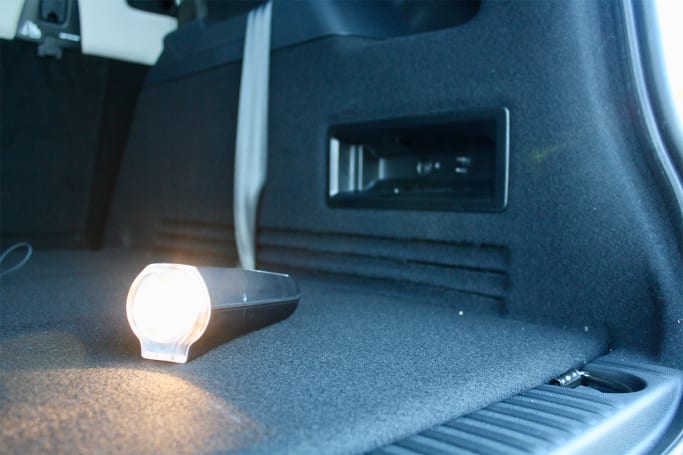
In the second row the seats are also individually operable, with all three sliding and/or folding as required. The outboard seats also have a clever seat base flip-up function, allowing them to move all the way forward for easier third-row access.
The space in the second row is easily good enough for three adults to slot across, though the roof-mounted middle seatbelt is a bit annoying. There are air-vents with fan controls mounted in the B-pillars, and the front seat-backs have clever flip-down tables with lighting, and there are mesh map pockets below. There is another 12-volt outlet, a pair of slim door pockets (not big enough for bottles), but no cupholders.
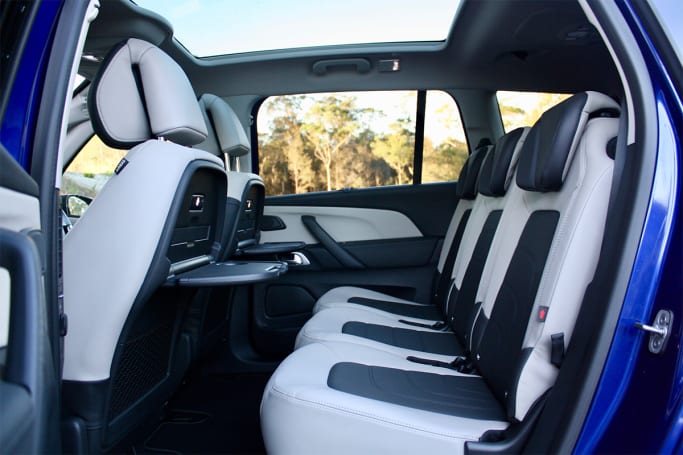
The front cabin is better sorted for storage of odds and ends - there is a pair of (small, shallow) cupholders between the seats, an enormous central console box that’s easily copious enough for phones, wallets, keys and the like, plus another storage area near where you plug in your USB/auxiliary device. The way the owners manual/logbook slots under the steering wheel is neat, and the glove box is fine, too, plus there are reasonably good sized door pockets, but again they lack sculpted bottle holsters.
One little issue I had was with the steering adjustment toggle - it’s quite springy… so much so that it sprung back and hurt my finger every time I adjusted it. That mightn’t be an issue if you’re the sole driver, but it’s worth noting.
As striking as the lovely leather trim is, the dashboard design is what I love most about this car. There’s a huge 12.0-inch high-definition top screen that shows you an enormous digital speed readout, plus you can have it show you the mapping and sat nav, or the car’s vital measures, or see where your car is positioned by way of the standard-fit 360-degree camera.
The lower 7.0-inch touchscreen is where the action happens: it’s your point of control for the media system, including Apple CarPlay and Android Auto smartphone mirroring, the dual-zone climate controls, car settings, and phone. There are supplementary volume and track controls, plus the steering wheel has things sorted pretty well in terms of ergonomics, too.
Okay, to clarify: I love this set up to a degree. I don’t like that the air conditioning controls (apart from de-mist for front and rear windscreens) are all within the lower screen, which means - on a really hot day, for instance - you have to fumble through menus and tap the screen repeatedly, rather than just turn a dial or two. Every sweaty second counts when it’s 40-degrees-plus outside.
Under the bonnet is a 1.6-litre petrol four-cylinder turbo unit producing 121kW of power (at 6000rpm) and 240Nm of torque (at a low 1400rpm). If you think about what other seven-seat people-movers have, that’s only okay - for instance, the cheaper LDV G10 people mover has 165kW/330Nm.
The Citroen may have a smaller engine capacity and outputs, but it’s also quite light - it weighs 1505kg (kerb weight) because it’s so small. The LDV, by contrast, weighs 2057kg. In short, it punches at, but not really beyond, its weight.
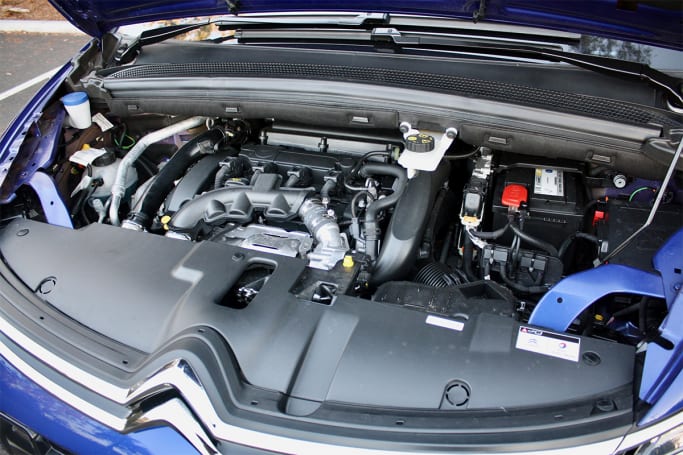
The Grand C4 Picasso is front-wheel drive, and uses a six-speed automatic transmission with a manual mode and paddle-shifters… yes, that seems unnecessary. The shifter is up on the steering column, which is an ingenious use of space, but the fact it has a dedicated manual mode means you may often choose M rather than D, particularly if you’re in a hurry.
If you plan to do a lot of towing, this isn’t the car for you. The claimed towing capacity is 600 kilograms for a trailer without brakes, or just 800kg for a braked trailer. The diesel is a better bet if that matters to you, with a 750kg un-braked/1300kg braked rating… though that’s still below average compared to some similarly priced petrol seven-seat SUVs like the Mitsubishi Outlander (750kg/1600kg), LDV D90 (750kg/2000kg) or Nissan X-Trail (750kg/1500kg).
The claimed fuel use for the Grand C4 Picasso petrol model is just 6.4 litres per 100 kilometres, which is rather impressive. It requires 95RON premium unleaded, meaning the cost at the pump can be markedly higher than regular 91RON.
In the real world, a lot of turbocharged cars tend to be thirstier than the claim suggests, but we saw a relatively decent 8.6L/100km during our time in the Grand C4 Picasso.
By comparison, the diesel is said to use a miserly 4.5L (17-inch wheels) or 4.6L (18s).
Let’s do some maths: the average cost per 1000km, based on claimed fuel usage, works out to $65 for the diesel and $102 for the petrol, and you’ll get about 40 per cent more distance per tank out of the diesel, and typically diesel is cheaper. But even so, the extra $6000 outlay on the initial purchase of the diesel will still take plenty of mileage before you break even.
The Citroen Grand C4 Picasso was crash tested back in 2014, and managed the maximum five-star ANCAP rating. But the criteria has changed in recent years, and there are some omissions on the petrol model when compared to the diesel.
The diesel, for instance, has adaptive cruise control and auto emergency braking (AEB), but buyers of the petrol miss out on those items, and they’re not optionally available, either. And all Grand C4 Picasso buyers miss out on third-row curtain airbag coverage, with the curtain ‘bags only stretching to the second row (there are six airbags total - dual front, front side and two-row curtains).
All that said, the car is still quite well stocked with other assistance tech: it has a forward collision warning system that works above 30km/h, a 360-degree camera system (with reversing camera and front corner cameras, too), speed limit recognition, auto high-beam lights, semi-automated park assist, blind-spot monitoring with steering assist, lane-keeping assist with steering function and driver fatigue monitoring.
And for what it’s worth, the vision from the driver’s seats, combined with camera system and the clarity of the top screen, is great.
Basic Warranty
5 years / unlimited km warranty
ANCAP Safety Rating

Citroen has just updated its ownership promise to consumers, with passenger vehicles attracting a five-year/unlimited kilometre warranty plan, which is backed by a five-year/unlimited kilometre roadside assist package.
Previously, the plan was three years/100,000km - and that’s even what some of the paperwork on the company’s site still suggests. We assure you, though, the five-year deal is legit.
Servicing is due every 12 months or 20,000km, whichever occurs first, under the Citroen Confidence Service Price Promise plan. The costs for the first three services are $414 (first service), $775 (second service) and $414 (third). That cost cover spans nine years/180,000km.
I’ve mentioned the word ‘charm’ already in this review, and the adjective to describe what I think about the drive experience is ‘charming’.
I love it.
It has that French suspension set-up that just doesn’t get bothered by sharp bumps because it has been tuned to deal with cobblestone alleyways. It rides beautifully at high and low speeds, loping over speed humps with ease, cosseting those in the cabin from the surface below.
It’s also tremendously quiet, with hardly any road noise intrusion in the cabin compared to the vast majority of cars out there. The coarse-chip surfaces of the M4 in Western Sydney usually offer up an ear-bashing, but not here.
The 1.6-litre engine is perky enough.
The steering is like that of a hatchback, with a tight (10.8m) turning circle enabling you to pivot on yourself more readily than you might think. The steering is also quite enjoyable if you like to drive, but don’t push too hard - understeer is an imminent threat, though the grip on offer is quite good.
The 1.6-litre engine is perky enough, and responds well both in stop-start traffic and on the highway - but there is no doubt about it, the 2.0-litre turbo diesel model’s 370Nm of torque makes for motoring with a lot less effort and strain. Not that the engine in the petrol model feels like it can’t get the job done - it just feels like it could do with a little more pulling power… Again, not enough to rule it out of contention, because it’s nicely refined.
The six-speed automatic is geared towards efficiency, which means that you might find it in third gear before a hill and somewhat hesitant to drop back a gear to gather more pace. I didn’t find this too annoying, but it did help me finally understand why the manual shift and paddles are fitted.
On the whole, there is a lot to like about this: it’s a family-focused car with family-focused dynamics on all fronts.
The lack of third-row airbags and AEB could be enough for you to rule this version of the Citroen Grand C4 Picasso out of contention as a family vehicle. We’d understand that.
But there are plenty of other reasons that it could be a contender on your people-mover shopping list. It’s a largely thoughtful car in a small and beautiful package… no matter what badge is stuck on the back of it.
| Vehicle | Specs | Price* | |
|---|---|---|---|
| Picasso Exclusive Bluehdi | 2.0L, Diesel, 6 SP AUTO | $22,880 – 28,270 | 2018 Citroen Grand C4 2018 Picasso Exclusive Bluehdi Pricing and Specs |
| Price and features | 8 |
|---|---|
| Design | 9 |
| Practicality | 9 |
| Under the bonnet | 7 |
| Efficiency | 8 |
| Safety | 6 |
| Ownership | 8 |
| Driving | 9 |
$22,880
Lowest price, based on third party pricing data